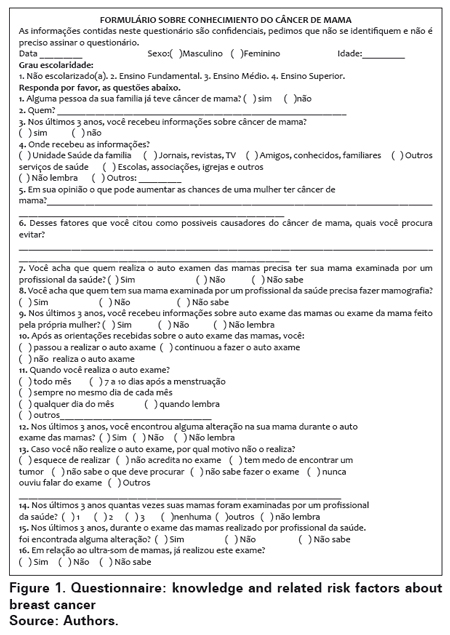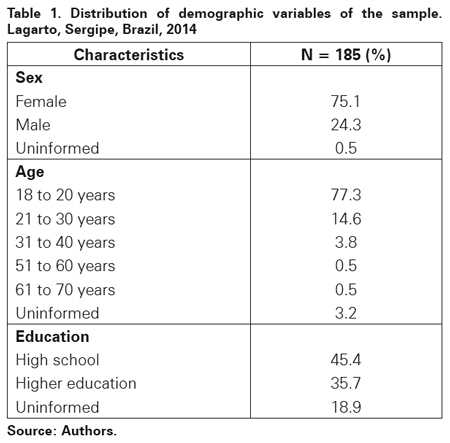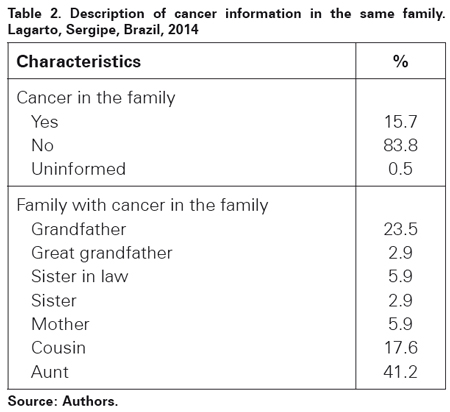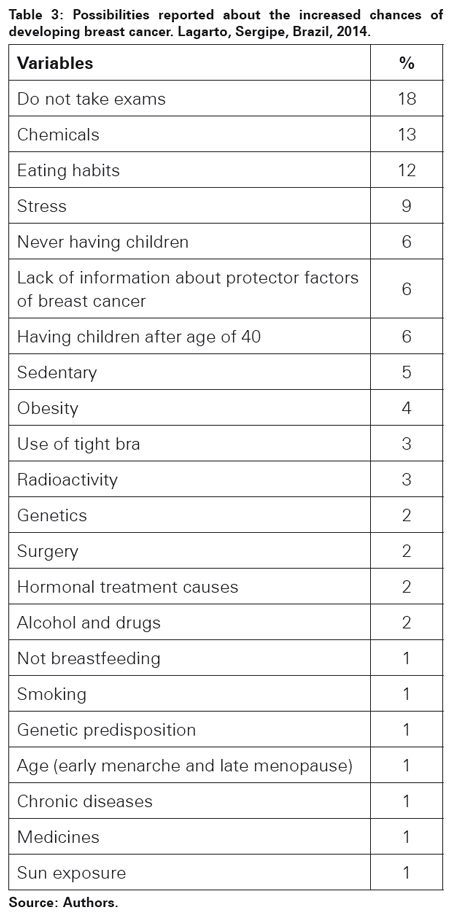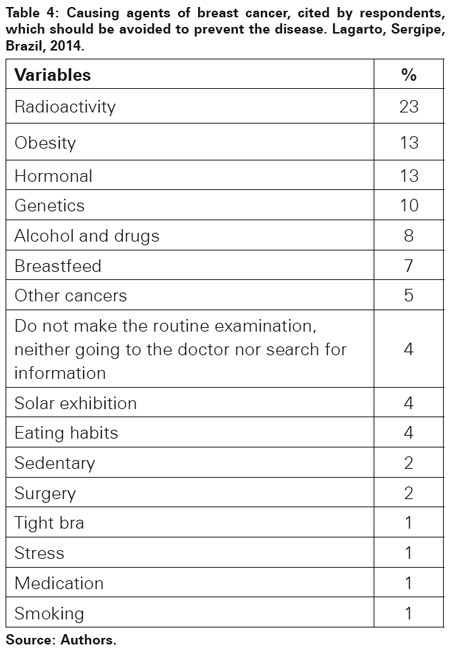Services on Demand
Journal
Article
Indicators
-
 Cited by SciELO
Cited by SciELO -
 Access statistics
Access statistics
Related links
-
 Cited by Google
Cited by Google -
 Similars in
SciELO
Similars in
SciELO -
 Similars in Google
Similars in Google
Share
Medicas UIS
Print version ISSN 0121-0319
Medicas UIS vol.29 no.1 Bucaramanga Jan./Apr. 2016
https://doi.org/10.18273/revmed.v29n1-2016004
DOI: http://dx.doi.org/10.18273/revmed.v29n1-2016004
Education and cancer prevention: knowledge of
brazilian students about breast cancer. Lagarto,
Brazil, 2014
Simone Yuriko Kameo*
Glebson Moura Silva**
Simone Otilia Cabral Neves**
Namie Okino Sawada***
Rhamon Ribeiro da Costa****
* Nurse. Doctoral Graduate Program in Fundamental Nursing. School of Nursing of Ribeirão Preto. University of São Paulo. Professor of Department of Health Education. University Federal of Sergipe. Aracaju. Sergipe. Brazil.
** Nurse. MsC in Public Health. Professor of Department of Health Education. University Federal of Sergipe. Aracaju. Sergipe. Brazil.
*** Nurse. PhD in Nursing. Professor of Department of Nursing. School of Nursing of Ribeirão Preto. University of São Paulo. Ribeirão Preto. São Paulo. Brazil.
**** Medical student. University Federal of Sergipe. Aracaju. Sergipe. Brazil.
Correspondence: Dr. Simone Yuriko Kameo. University Federal of Sergipe. Campus Professor Antônio Garcia Filho. Department of Health Education at University Federal of Sergipe. Avenida Marechal Rondon, S/n. Jardim Rosa Elze, São Cristóvão. Sergipe. Brazil. CEP 49100-000. E-mail: simonekameo@hotmail.com
Artículo recibido el 13 de enero de 2015 y aceptado para publicación el 1 de noviembre de 2015
ABSTRACT
Introduction: breast cancer is the leading cause of death among Brazilian women, 57 120 new cases are expected in 2015. Therefore, there is the need for strategic actions aimed at prevention and early diagnosis. Health education is an action directed on the knowledge of people, and this process helps to reduce cancer morbidity and mortality statistics. Objective: to identify the knowledge level of students in relation to breast cancer, its risk factors and how to prevent them. Material and methods: this is a quantitative, descriptive and exploratory research. Healthcare academics at Federal University of Sergipe conducted a presentation targeted to high school students from public schools, dramatizing real situations, emphasizing prevention and early diagnosis of breast cancer, and after that, they performed data collection using a questionnaire related to breast cancer prevention. Ethical issues were followed according to Resolution 466/12 of the National Health Council. Results: the sample consisted of 185 students, mostly female, between 18 to 20 years old, attending high school. In the last three years, 80.5% reported having received information on breast cancer; 53% received information on breast self-examination. Even after receiving knowledge about the prevention of breast cancer, 61.1% did not perform the breast self-examination; among the ones who did it, 64.9% did not find changes in the breast. Knowledge and awareness of women about breast cancer seem to be related to the delay in diagnosis and also in adherence to screening practices. Conclusion: most people received information about breast cancer, but do not use it correctly. Even though not being able to change some risk factors such as age and family history, the information about prevention is useful for women to know their risks and can take a conscious attitude to early detection. MÉD UIS. 2016;29(1):37-44.
Keywords: Breast neoplasms. Health education. Students.
Educação e prevenção do câncer: conhecimento de estudantes sobre câncer de mama
RESUMO
Introdução: O câncer de mama é a principal causa de morte nas mulheres brasileiras, são esperados 57 120 casos novos para 2015. Por isso há a necessidade de ações estratégicas voltadas à sua prevenção e diagnóstico temprano. A educação em saúde é um trabalho dirigido para atuar sobre o conhecimento das pessoas, e este processo contribui para diminuir as estatísticas de morbimortalidade de câncer. Objetivo: identificar o nível de conhecimento de estudantes em relação ao câncer de mama, seus fatores de risco e como preveni-los. Materiais e métodos: trata-se de pesquisa quantitativa, descritiva e exploratória, em que acadêmicos da área da saúde da Universidade Federal de Sergipe, realizaram apresentação de sociodrama, direcionados aos alunos de ensino médio de escolas estaduais, dramatizando situações reais, enfatizando a prevenção e diagnóstico precoce do câncer de mama e após realizaram coleta de dados com uso de questionário com perguntas referentes aos ao tema prevenção do câncer de mama. Questões éticas foram seguidas conforme resolução 466/12 do Conselho Nacional de Saúde. Resultados: A amostra foi composta por 185 estudantes, maioria do sexo feminino, entre 18 a 20 anos, cursando ensino médio. Nos últimos 3 anos, 80,5% relataram ter recebido informações sobre câncer de mama; 53% receberam informações sobre autoexame das mamas. Mesmo após terem recebido conhecimentos sobre a prevenção do câncer de mama, 61,1% não realizaram o autoexame das mamas, das que realizaram, 64,9% não encontraram alterações nas mamas. O conhecimento e a consciência das mulheres a respeito do câncer de mama parecem estar relacionados com o atraso no diagnóstico e também na adesão às praticas de rastreamento. Conclusão: a maioria recebeu informações sobre câncer de mama, porém não o utilizam corretamente. Mesmo não sendo possível mudar alguns fatores de risco, como idade e história familiar, a informação é útil para que as mulheres conheçam os seus riscos e possam assumir uma atitude consciente quanto à detecção precoce. MÉD UIS. 2016;29(1):37-44.
Palavras chave: Neoplasias da mama. Educação em saúde. Estudantes.
How to cite this article? Kameo SY, Moura G, Cabral SO, Sawada NO, Ribeiro R. Education and cancer prevention: knowledge of brazilian students about breast cancer. Lagarto, Brazil, 2014. MÉD UIS. 2016;29(1):37-44.
INTRODUCTION
Cancer is listed among the leading causes of morbidity and mortality worldwide1. The high rates of incidence and mortality built over the decades the rigid paradigm of a disease that does not have prevention, treatment or cure. This perception has been changed by scientific and technological advances on this subject.
Cancer is characterized by uncontrolled growth and spread of abnormal cells in the body. Among all cancers, breast cancer is the most frequently diagnosed in women2. It is estimated that each year are occurring more than 1 050 000 new cases of breast cancer worldwide3. 57 120 new cases of breast cancer are expected in Brazil in 2015, with an estimated risk of 56.09 cases per 100 000 women1.
The incidence of cancer is increasing overwhelmingly among the population, due to the demographic transition we are experiencing nowadays, as well as the growing exposure of the population to carcinogens environmental agents1. These facts reinforce the need for public policies aimed at the prevention and early diagnosis, as measures to reduce the strategic impacts that this disease causes.
Primary prevention of breast cancer does not actually prevent the development of the disease, but preventive measures act in reducing the likelihood of it. Some predeterminated risk factors can involve pontencially irreparable changes such as age, genetics, family history, atypical mammary hyperplasia, radiation exposure, reproductive factors such as long periods of menstrual history (early menarche and late menopause), nulliparity, first pregnancy to term after 30 years of age, absence or short periods of breastfeeding, weight gain after 18 years of age, overweight or obese after menopause, use of hormone therapy, physical inactivity, smoking and alcohol4,5.
Secondary prevention aims to enable early diagnosis and treatment3, which has great importance since early diagnosis is directly proportional to the chances of cure. Even with this knowledge, in this country, 10 000 women die every year due to late diagnosis, the main determinant of the intractability of the tumor. This fact is mainly because, in 60% of cases, the disease is detected at an advanced stage6, which makes breast cancer a public health problem in Brazil7.
Therefore, awarness of people regarding breast cancer becomes evident. This is possible with the active participation of professionals and the public. Furthermore, it is important for the proper development of any health action, an organized system of health and in hierarchical levels of complexity in their care, citing as an example the implementation of a health education with educational campaigns involving breast self-examination, the need for annual gynecological examination and the development of educational activities involving women's health.
According to Branco8, health education is a process oriented towards the use of strategies that assist the individual to adapt to behaviors that enable a healthy state. Health education should be influenced by cultural, social and economic dimension in which the population lives and professionals should seek greater knowledge of the community assisted in the pursuit of improving the quality of life.
It is considered that over 70% of cancers are determined by extrinsic agents to the body, closely linked to the environment and lifestyles of the people. Therefore, the promotion of health, prevention and early diagnosis of cancer are powerful weapons that health professionals have to control the increase of the disease1.
Thus, the educational process contributes to reducing cancer mortality statistics, in this case, breast cancer. This study aims to identify the level of knowledge of high school students in relation to breast cancer, its risk factors and how to prevent them. It has the possibility to benefit them through mentoring, mobilization to an early diagnosis of premalignant lesions, and provide subsidies for learning and do scientific research about this theme.
MATERIALS AND METHODS
This is a quantitative, descriptive and exploratory field research. Data were collected in the city of Lagarto, Sergipe, Brazil, in September-November 2013 period. Two schools were selected for this study: one public state school which offers classes for elementary and secondary education, and students from health area of the Federal University of Sergipe (UFS). The study subjects were high school students and students of healthcare area UFS, both located in the town of Lagarto, Sergipe, Brazil. This research project is inserted into the extension project titled: "Life project: prevention and diagnosis of cancer," sponsored by the UFS faculty and students enrolled in courses in the health area.
All professionals and students involved in the project extension underwent previous training promoted by the professors, in order to obtain knowledge about breast cancer, so that each of these individuals was a multiplier of this knowledge. From there, the action of preventing breast cancer was proposed by using a dramatization on the topic, where academics dramatize real situations with a comedic approach, emphasizing in prevention and early diagnosis of breast cancer, as well as guidance on the concept of breast cancer, breast anatomy and physiology, risk factors, myths and truths, diagnosis and prevention.
The following inclusion criteria were defined as students duly enrolled and attending the public high school or college in the city of Lagarto, Sergipe, Brazil, aged 18 or more and who accepted to participate in the research. The exclusion criteria were students with impaired cognitive function that made it difficult to respond to the questionnaires, or under 18 years old. The signature of the student in terms of free consent, without burden or financial benefits, according to Resolution 466/12 of the National Health Council9 was requested.
The instrument used for data collection was developed especially for this purpose, drawn from the constructs raised by documentary research and literature review, beyond the experience of researchers. The organization of these items is critical for understanding the particularities related to the prevention of breast cancer and to identify problems. Subsequently, it was submitted to five judges among nurses, biologists and dentists, who had worked in the oncology area for at least 5 years, and after a mutual agreement, the researchers adjusted the questions according to the suggestions provided. A group of 10 students tested the understanding of the instrument, and it was reworked. The pre-test was focused in order to clarify, refine and measure the length of the instrument10. The survey also had authorization of the college and university, and then the data were collected.
The questionnaire (Figure 1) consisted of 16 structured questions concerning knowledge, related risk factors and cancer, in particular, breast cancer form. The procedures for sample selection were not probabilistic, sample size for convenience, applied before activity guidance on the theme explored in order to evaluate the acquisition and assessment of information.
The results were obtained through questionnaire responses and explanations of students using statistical method, calculated frequency and percentage for categorical variables, with excel program. It was used in order to provide a quantitative definition of society, the results were presented in graphical and analytical tables.
RESULTS
The sample consisted of 185 students, mostly female, more present age between 18 and 20 years, attending high school, as described in the table 1. Regarding information about the presence of cancer in the family, is described in Table 2.
When asked if in the last 3 years, received information on breast cancer, 80.5% received, 18.4% did not receive and 1.1% did not answer. Among those who received information, these were sourced from newspapers, magazines and television (51.2%), schools, associations, churches (16.5%), friends, colleagues and family (13%), "Unidade Saúde da Família" (9.4%), other health services (5.1%), others not described (3.9%), do not remember (0.8%).
They also were asked about the possible factors that can lead to increased chances of having breast cancer, and the majority (18%) reported that the non-realization of the breast cancer exam can increase the chances of diagnosing it, followed the use of chemicals (13%) and poor eating habits (12%). All reported possibilities are described in Table 3 and table 4 shows the possible causes of breast cancer, the respondents seek to avoid.
About the need to be a professional healthcare that performs breast self-examinations accurately, 88.1% answered affirmative, 5.9% did not know, 4.9% answered negative, and 1.1% did not answer. When asked about the need to have mammograms instead of breast examination, 77.8% answered negative, 7.6% affirmative, 14.6% did not know.
Over the past three years, 53% received information on breast self-examination, 24.3% did not receive, 16.8% do not remember and 5.9% did not respond. After the guidance received about breast self-examination, 61.1% did not undergo breast self-examination, 16.6% had a breast-self exam, 9.7% continued to do breast self-examination and 12.4% did not answer. Besides, 16.2% reported doing breast self-examination when remembered, 7% any day of the month, 5.9% from seven to 10 days after menstruation, 3.7% did it every month, 43.8% reported not doing it and 23.2% did not answer. When asked to women if during the last 3 years, any changes in the breast was perceived during breast self-examination, 64.9% responded negatively, 9.7% answered yes and 25.4% did not answer. Among those who do not perform self examination, they did not do it because of neglect to perform (24.9%), did not know how to do the exam (16.8%), had never heard of the test (3.2%), are afraid to find a tumor (2.2%), reported other reasons (22.2%) and did not answer (25.4%).
Over the past three years, 6.5% responded that they had a breast examination by a health professional two times, 5.9% any time and 3.2% three times. Among those who were examined, changes were found in 68.6% of the cases, 2.7% had other responses not reported, 4.3% do not remember and 8.6% did not respond. 79.5% did not undergo ultrasound, 10.8% have already done it, 2.7% do not know and 7% did not answer.
DISCUSSION
The development of studies about the knowledge and practice between different population groups in relation to breast cancer, can provide useful information for the identification of factors that may interfere in the adherence to proposed actions by the health services and the adoption of preventive practices, in addition to direct planning effective actions to control cancer. Knowledge of demographic characteristics becomes relevant, since subsidize understanding of factors related to people's participation in the actions proposed for the early detection and prevention of breast cancer. In previous studies, there are influences of some characteristics of women in the use of health services11-13.
The knowledge and awareness of women about breast cancer, appears to be related to delay in diagnosis and also in adherence to screening practices14. In this study, 53% reported receiving some type of information about breast cancer in the last 3 years.
In a survey conducted with 393 women users of the "Unidade Saúde da Família" in Dourados, Mato Grosso do Sul, Brazil, Batiston et al5 found that most respondents had some knowledge about breast cancer, but nearly half were unaware of their risk factors. In this study, among those who received information, most of it was from newspapers, magazines and television (51.2%). It was reported that no conduct of examinations (13%) and the use of chemicals (12%) increase the chances of having breast cancer. This reinforces the finding that knowledge of Brazilian women in this area focuses mainly on methods of detection of breast cancer. Risk factors are poorly understood by women and also little attention in educational activities among the population. However, despite not being able to change some risk factors such as age and family history, the information is useful for women to recognize their risks and can take a conscious attitude to early detection.
The modifiable risk factors for breast cancer are excessive alcohol consumption, overweight, especially after menopause, and hormone replacement therapy15. Healthy eating, physical activity and appropriate body weight, plus breastfeeding, are practices that can reduce the risk of breast cancer4. It is estimated that is possible to avoid 28% of cases of the disease through factors related to food, nutrition and physical activity16.
The information is only one aspect in the set of sociocultural dimensions to be considered in respect of the subject with body and health. It should not be the center of educational processes in health, but assertive dialogue that acknowledges the multiple factors that modulate beliefs and behaviors of individuals and groups17.
On the completion of Clinical Breast Examination (Exame Clínico da Mama, ECM, for its acronyme in Portuguese), in 2008, Pesquisa Nacional por Amostra de Domicílios showed that about 25% of Brazilian women aged 40 years or more, had never performed the ECM until the interview date, which indicates the shortcoming full health care woman and early diagnosis of breast cancer18. Okonkwo19 suggest that the annual completion of the ECM women between 40 to 60 years in developing countries, demand half the resources used for mammographic screening and appears to be as effective in reducing mortality as biennial mammography in the same range age.
The prevalence of women who never underwent mammography at age recommendation in Brazil seems high. The national guidelines for screening for breast cancer, published by the Instituto Nacional de Câncer in 200420, advocated the realization of mammography for women 50 to 69 years every two years. The increased access to screening mammography in women aged 50 to 69 years and the qualification of the care network are thrusts of the National Plan to strengthen the prevention, diagnosis and treatment of cancer, in 2011, the network and also in the Strategic Action Plan for Confronting Chronic Noncommunicable Diseases 2011-20227.
Contrary to what some authors postulate21, the balance between risks and benefits of screening mammography is not favorable for all women, regardless of age. For women under 50 years or 74 years or more, the results of several clinical trials indicate that recommend mammography screening for these groups can result in more harm than good22,23.
These studies indicate that biological questions, such as increased breast density, which results in lower test sensitivity (high number of false-negative cases) and lower specificity (high number of false-positive cases), and higher rates of interval tumors, are sufficient to justify the exclusion of women under 50 years with a standard risk in mammographic screening programs24 factors. Thus, it is particularly important to tell the woman at that age, that the possibility of a mammogram before age 50 had a suspicious result is high and that if this occurs, it must perform additional imaging and / or biopsy that does not necessarily lead to a diagnosis of cancer23. What exactly refers to the sample used, which demonstrated a relationship between age commonly reported by the media and the preoccupation with illness. Therefore, this type of information, along with the knowledge of risk factors, collaborates with a new idea to raise awareness about breast cancer.
In the prevention and diagnosis are intrinsic a way of life of the brazilian woman who must face it regardless of age, as well as other most frequent concerns that accompany menarche. As suggestions of possible proposals to improve this scenario of breast cancer, awareness actions are suggested on the prevention of this disease through campaigns, chats, lectures, promotion of free screening, exhibition information in schools, health facilities and shopping, walks, runs, among other activities.
It is important that a new research be conducted with the topic. This study has the limitation of involving students at only one public school in the city of Lagarto, but we consider as yet another contribution to research in oncology and a stimulus for the development of future work in the area of prevention of breast cancer.
CONCLUSION
There is little information about the actual risk factors and causative agents associated with the disease, and consequently few students actually perform adequately the prevention of this disease. The information resulting from this work can support the decisions of managers and health policies in this area, contributing to more effective planning strategies for prevention and early diagnosis of cancer, risk communication to the public, and consequently a reduction in the number of deaths and an undeniable social and economic value to society. It is hoped that with greater knowledge about breast cancer, occurs an increased demand of the population in relation to preventive exams and even in search of existing cancer treatments.
With the knowledge of breast cancer in Lagarto, was possible to know the limitations of students, specificities, in relation to the concentration of patients or at risk for developing breast cancer people. In this context, it will be possible to support the development of specific and unique preventive strategies and thus a more effective cancer control in the city, especially with prior knowledge of the risk of these people.
It was focused on the reproduction of existing knowledge that contributes to the formation of a society more aware of the risks, with a less terrified of myths, and more rational with possibilities. However, the prioritization of other educational activities in health, especially when it comes to strategies used by the Basic Health Units in favor of Women's Health for it to become real, is required.
Thus, the continuity of this work is important to the achievement of extraterritorial levels, with the potential to create up a national standard of care that aims to change the paradigms of disease and increased professional preparation in the host. Providing a more accessible prevention, more effective detection and more frequent cases of healing.
CONFLICT OF INTEREST
Authors declare no conflict of interest.
ETHICAL AND LEGAL CONSIDERATIONS
Ethical issues were followed according to Resolution 466/12 of the National Health Council in Brazil.
FINANCING
Authors declare own funding while doing this research.
ACKNOWLEDGMENTS
Authors thank the high school and college students, teachers and institutions involved.
REFERENCES
1. Brasil. Ministério da Saúde. Instituto Nacional de Câncer José Alencar Gomes da Silva. Coordenação de Prevenção e Vigilância [Internet]. Estimativa 2014: incidência de câncer no Brasil. Rio de Janeiro: INCA; 2014 [citado 2014 jun 2]. Disponível en: <http://www.inca.gov.br/estimativa/2014/estimativa-24042014.pdf> [ Links ]
2. Lee JH, Glick HA, Hayman JA, Solin LJ. Decision-analytic model and cost-effectiveness evaluation of postmastectomy radiation therapy in high-risk premenopausal breast cancer patients. J Clin Oncol. 2002;20(11):2713-25. [ Links ]
3. Matos JCde, Pelloso SM, Carvalho MDB. Fatores associados à realização da prevenção secundária do câncer de mama no Município de Maringá, Paraná, Brasil. Cad. Saúde Pública. 2011;27(5):888-898. [ Links ]
4. Inumaru LE, Silveira EA, Naves MMV. Faátores de risco e de proteção para câncer de mama: uma revisão sistemtica. Cad. Saúde Pública. Rio de Janeiro. 2011; 27(7):1259-1270 . [ Links ]
5. Batiston AP, Tamaki EM, Souza LAde, Santos MLM. Conhecimento e prática sobre os fatores de risco para o câncer de mama entre mulheres de 40 a 69 anos. Rev. Bras. Saude Mater. Infant. 2011; 11(2): 163-171. [ Links ]
6. Kim DD, Araujo ALL, Tsai AIA, Kojima FH, Takashima JSI, Otsuka JLF, et al . Saber é prevenir: uma nova abordagem no combate ao câncer de mama. Ciênc. saúde coletiva . 2008;15(Suppl 1):1377-1381. [ Links ]
7. Brasil. Tribunal de Contas da União. Política Nacional de Atenção Oncológica: relatório de auditoria operacional. Brasília: TCU, 2011 (cited 2014 apr 12). Available from: URL: http://portal2.tcu.gov.br/portal/page/portal/TCU/comunidades/programas_governo/areas_atuacao/saude/Rel_Oncologia.pdf. [ Links ]
8. Bata IM, Branco HP. Prevenção do câncer e educação em saúde: opiniões e perspectivas de enfermagem. Texto Contexto Enferm. 2005;14(2):246-9. [ Links ]
9. Brasil. Ministério da Saúde. Conselho Nacional de Saúde. Resolução n. 196/96. Diretrizes e normas regulamentadoras sobre pesquisa envolvendo seres humanos. Diário Oficial República Federativa do Brasil. Brasília, 1996. [ Links ]
10. Hulley SB, Newman TB, Cummings, SR. Escolhendo os sujeitos do estudo: especificação, amostragem e recrutamento. In: Delineando a pesquisa clínica: uma abordagem epidemiológica. Tradução Michael Schmidt Duncan e Ana Rita Peres. 2.ed. Porto Alegre: Artmed, 2003. Cap. 3, p. 41-54. [ Links ]
11. Weinmann S, Taplin SH, Gilbert J, Beverly RK, Geiger AM, Yood MU, Mouchawar J, et al. Characteristics of women refusing follow-up for tests or symptoms suggestive of breast cancer. J Natl Cancer Inst Monogr. 2005;(35):33-8. [ Links ]
12. Marchi AA, Costa-Gurgel MS, Fonsechi-Carvasan GA. Rastreamento mamográfico do câncer de mama em serviços de saúde públicos e privados. Bras Ginecol Obstet. 2006;28(4):214-9. [ Links ]
13. Dias-da-Costa JS, Olinto MTA, Bassani D, Marchionatti CRE, Bairros FS, Oliveira MLP, et al. Desigualdades na realização do exame clínico de mama em São Leopoldo, Rio Grande do Sul, Brasil. Cad. Saúde Pública. 2007;23(7):1603-12. [ Links ]
14. Seah M, Tan SM. Am I breast câncer smart? Assessing breast cancer knowledge among healthcare professionals. Singapore Med J. 2007;48(2):158-62. [ Links ]
15. World cancer report 2008. Lyon: IARC, 2008. [ Links ]
16. Instituto Nacional de Cáncer. Sumário executivo. Políticas e ações para prevenção do câncer no Brasil: alimentos, nutrição e atividade física. Rio de Janeiro. INCA, 2009. [ Links ]
17. Estermann D, Falleiros D, ValadãoIII M, de Carvalho J. "Você aprende. A gente ensina?" Interrogando relações entre educação e saúde desde a perspectiva da vulnerabilidade. Cad. Saúde Pública. 2006;22(6):1335-42. [ Links ]
18. Instituto Nacional de Cáncer. Rastreamento organizado do câncer de mama: a experiência de Curitiba e a parceria com o Instituto Nacional de Câncer. Rio de Janeiro: INCA, 2011. [ Links ]
19. Okonkwo QL, Draisma G, der Kinderen A, Brown ML, de Koning HJ. Breast cancer screening policies in developing countries: a cost-effectiveness analysis for India. J Natl Cancer Inst. 2008,100(18):1290-300. [ Links ]
20. Instituto Nacional de Câncer José Alencar Gomes da Silva. Recomendações para redução da mortalidade por câncer de mama no Brasil: balanço 2012/Instituto Nacional de Câncer José Alencar Gomes da Silva. Rio de Janeiro; 2012.52 p. [ Links ]
21. Badgwell BD, Giordano SH, Duan ZZ, Fang S, Bedrosian I, Kuerer HM et al. Mammography before diagnosis among women age 80 years and older with breast cancer. J Clin Oncol. 2008;26(15):2482-88. [ Links ]
22. Welch HG, Schwartz L, Woloshin S. Overdiagnosed: making people sick in the pursuit of health. Boston: Beacon Press; 2011. [ Links ]
23. Salas D, Ibáñez J, Román R, Cuevas D, Sala M, Ascunce N, et al. Effect of start age of breast cancer screening mammography on the risk of false-positive results. Prev Med. 2011;53(1-2):76-81. [ Links ]
24. Mandelblatt JS, Cronin K, Bailey S, Berry D, Harry J, Draisma G, et al. Effects of mammography screening under different screening schedules: model estimates of potential benefits and harms. Ann Intern Med. 2009;151(10):738-47. [ Links ]
25. Fe de errata en Ann Intern Med. 2012;152(2):136. [ Links ]













